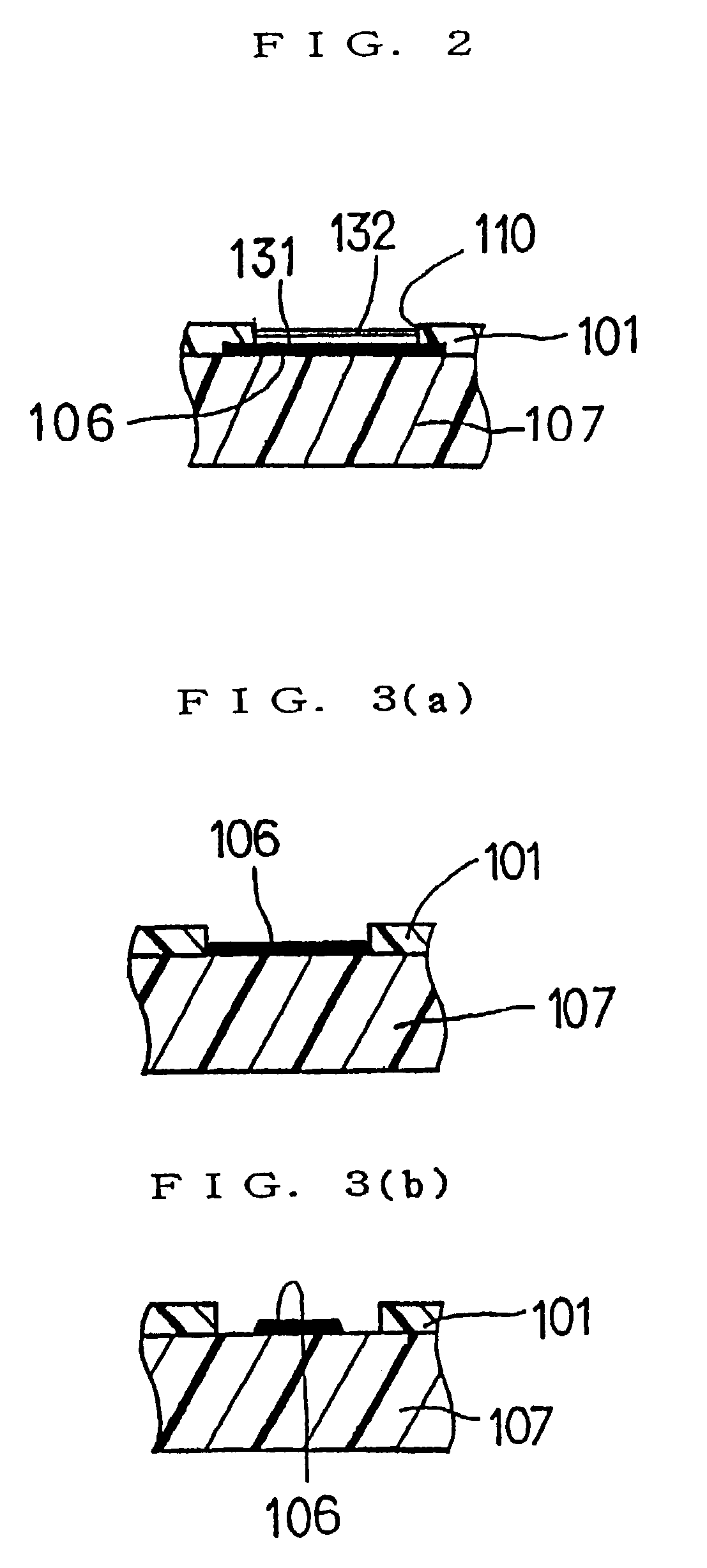Printed wiring board and method of manufacturing the same
a technology of printed wiring and insulating film, which is applied in the direction of lithographic masks, non-metallic protective coating applications, etching metal masks, etc., can solve the problems of no solder resist suitable as insulating film, and no high density mounting can be improved. , to achieve the effect of high temperatur
- Summary
- Abstract
- Description
- Claims
- Application Information
AI Technical Summary
Benefits of technology
Problems solved by technology
Method used
Image
Examples
embodiment mode example 1
[0165]A manufacturing method of a printed wiring board in an embodiment mode example of a first invention will be explained by using FIGS. 1 to 3.
[0166]A summary of this manufacturing method will first be explained. That is, a solder resist constructed by thermosetting resin is printed on the surface of an insulating substrate 107 having a conductor circuit 106 and including a surface of this conductor circuit 106. The solder resist is thermally cured so that an insulating film 101 having a low coefficient of thermal expansion is formed (FIG. 1(a)). Next, a laser beam 102 is irradiated to an opening portion forming portion in the insulating film 101 and this opening portion forming portion is burnt out, and an opening portion 110 is formed and one portion of the conductor circuit 106 is exposed (FIG. 1(b)).
[0167]A manufacturing method of the above printed wiring board will next be explained in detail.
[0168]First, a copper foil having 18 μm in thickness is stuck to an insulating subs...
embodiment mode example 2
[0182]A printed wiring board in an embodiment mode example of a second invention will be explained by using FIGS. 4 to 7.
[0183]As shown in FIG. 4, the printed wiring board 208 in this example has an upper face pattern 201 formed on an upper face of an insulating substrate 207, a lower face pattern 202 formed on a lower face of the insulating substrate 207, and a hole 203 for conductivity extending through the insulating substrate 207 and reaching an upper face 228 of the lower face pattern 202. A metallic filling material 205 is arranged within the hole 203 for conductivity and is filled with solder for electrically conducting the upper face pattern 201 and the lower face pattern 202. The upper face pattern 201 is covered with a resist film 261 except for a peripheral portion of the hole 203 for conductivity.
[0184]The insulating substrate is set to have 0.1 mm in thickness. As shown in FIG. 5, the hole 203 for conductivity has a diameter A of 0.3 mm. An upper end portion 231 of the ...
embodiment mode example 3
[0197]This example is an embodiment mode example of the second invention. This example differs from the embodiment mode example 2 in that the interior of the hole for conductivity is filled with a metal by a printing method.
[0198]Specifically, similar to the above embodiment mode example 2, after the hole for conductivity is formed, a mask for printing having an opening hole in a portion corresponding to the hole for conductivity is arranged on an upper face side of the insulating substrate. Next, soldering paste is arranged on the mask and is pressed by a roller. Thus, the soldering paste is moved from the opening hole of the mask into the hole for conductivity. Accordingly, the interior of the hole for conductivity is filled with the solder so that a metallic filling material is formed.
[0199]The others are similar to those in the embodiment mode example 2.
[0200]In this example, effects similar to those in the embodiment mode example 2 can be also obtained.
PUM
| Property | Measurement | Unit |
|---|---|---|
| Temperature coefficient of resistance | aaaaa | aaaaa |
| Metallic bond | aaaaa | aaaaa |
| Thermal expansion coefficient | aaaaa | aaaaa |
Abstract
Description
Claims
Application Information
 Login to View More
Login to View More - R&D
- Intellectual Property
- Life Sciences
- Materials
- Tech Scout
- Unparalleled Data Quality
- Higher Quality Content
- 60% Fewer Hallucinations
Browse by: Latest US Patents, China's latest patents, Technical Efficacy Thesaurus, Application Domain, Technology Topic, Popular Technical Reports.
© 2025 PatSnap. All rights reserved.Legal|Privacy policy|Modern Slavery Act Transparency Statement|Sitemap|About US| Contact US: help@patsnap.com



